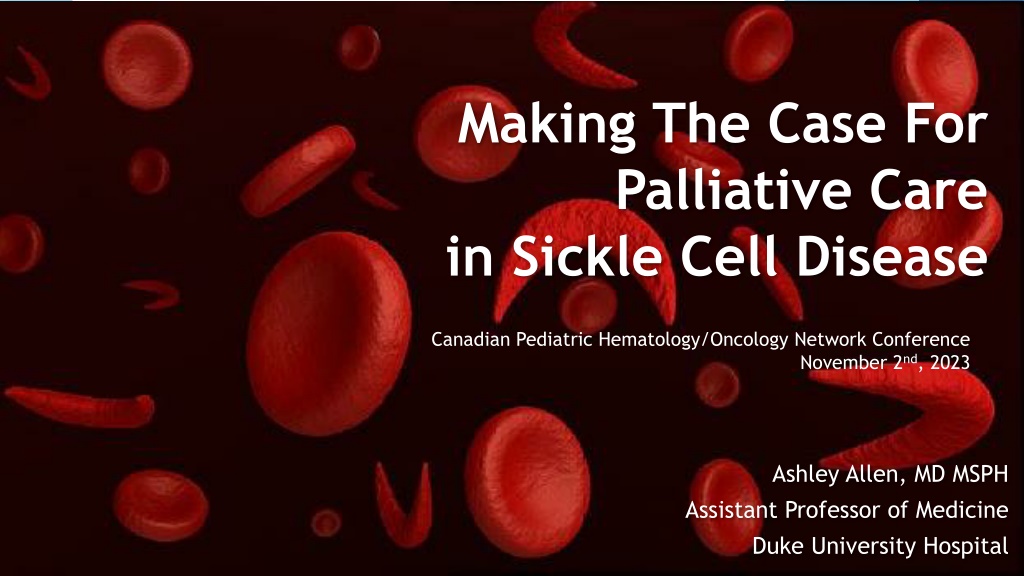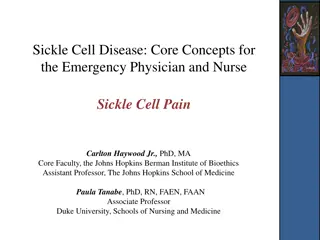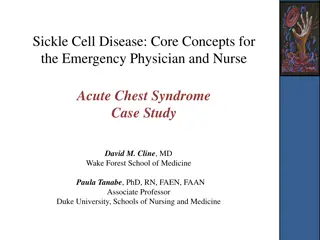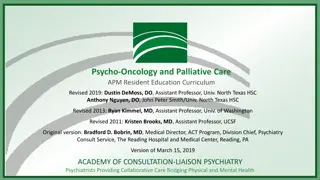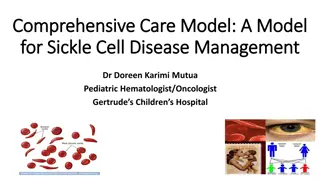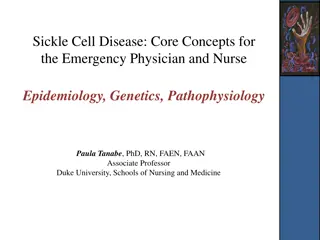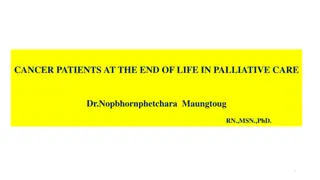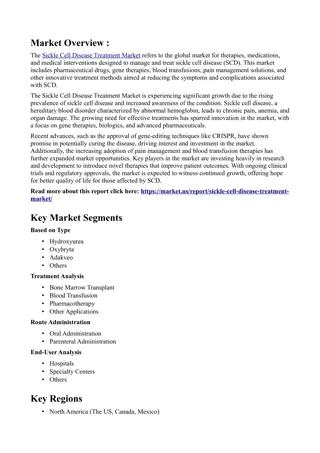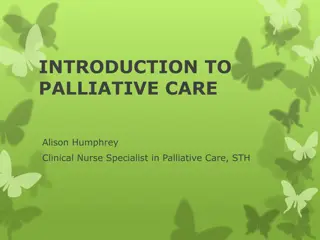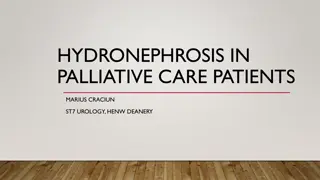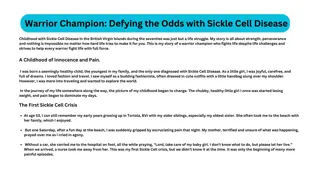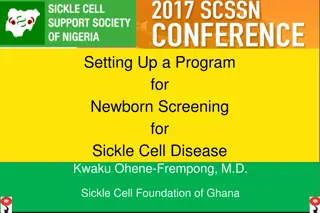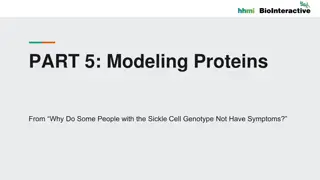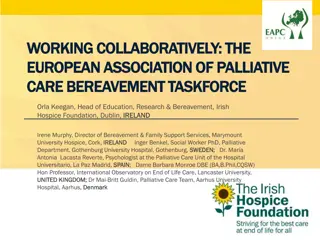Palliative Care in Sickle Cell Disease: Enhancing Quality of Life
Explore the importance of palliative care in sickle cell disease, focusing on biopsychosocial factors and quality of life impacts. Review literature related to palliative care, advance care planning, and end-of-life care in SCD. Learn about potential roles for palliative care involvement to enhance patient well-being.
Download Presentation

Please find below an Image/Link to download the presentation.
The content on the website is provided AS IS for your information and personal use only. It may not be sold, licensed, or shared on other websites without obtaining consent from the author. Download presentation by click this link. If you encounter any issues during the download, it is possible that the publisher has removed the file from their server.
E N D
Presentation Transcript
Making The Case For Palliative Care in Sickle Cell Disease Canadian Pediatric Hematology/Oncology Network Conference November 2nd, 2023 Ashley Allen, MD MSPH Assistant Professor of Medicine Duke University Hospital
Disclosure Slide I have no relevant financial or non- financial disclosures to report related to the content of this presentation.
Objectives 1. Understand the key biopsychosocial factors in sickle cell disease and highlight their impacts on health-related quality of life. 2. Review and synthesize the literature in sickle cell disease related to palliative care, advance care planning and end of life care. 3. Outline potential roles for palliative care involvement in sickle cell disease.
Outline Quality of Life/Psychosocial Aspects of SCD Literature in SCD + Palliative Care Role(s) For Palliative Care Next Steps
Outline Quality of Life/Psychosocial Aspects of SCD Literature in SCD + Palliative Care Role(s) For Palliative Care Next Steps
Complications in SCD
Longitudinal cohort study of over 200 adult patients with SCD Pain in Sickle Cell PISCES STUDY Epidemiology Study(PiSCES) HRQOL measured using Medical Outcome Study 36-SF- 8 domains including: physical function, physical role functions, emotional role functioning, bodily pain, vitality, general health, mental health and social function. Participants completed daily pain diaries 3 variables calculated: mean daily pain, % days in crises, %utilization Smith WR, Penberthy LT, Bovbjerg VE, et al. Daily assessment of pain in adults with sickle cell disease. Ann Intern Med 2008; 148:94. Smith WR, McClish DK, Dahman BA, et al. Daily home opioid use in adults with sickle cell disease: The PiSCES project. J Opioid Manag 2015; 11:243.
PiSCES Study: Results 55% of total days with pain 29% patients reported daily pain Pain managed entirely at home on 38% of days 80% of those days included use of opioids At least 10% used non-opioid analgesia for pain control VOC utilizing medical care 3.5% of days Mean SCD pain highly predictive of poorer HRQOL Pain is the rule, not the exception Smith WR, Penberthy LT, Bovbjerg VE, et al. Daily assessment of pain in adults with sickle cell disease. Ann Intern Med 2008; 148:94. Smith WR, McClish DK, Dahman BA, et al. Daily home opioid use in adults with sickle cell disease: The PiSCES project. J Opioid Manag 2015; 11:243.
Sickle Cell Disease: The Pain Burden Misperceptions: Words matter and can perpetuate bias: 1997 Survey: 50% of ED physicians and 23% of hematologists believed that SCD patients were addicted to opioids Sickler Pain Crisis Frequent flier 2005 Survey: 86% of teaching hospital physicians did not believe that patient s own self report was the best indicator of their actual pain Drug seeker Shapiro BS, Benjamin LJ, Payne R, Heirich G. Sickle cell-related pain: perceptions of medical practitioners. J Pain Symptom Manage. 1997;14:168-174.
Frequently delayed Sickle Cell Disease: The Pain Burden SCD pts wait 25 50% longer in the ED1 Often undertreated or inappropriately managed2 --> pseudo addiction Frequency of VOC: 1/3 = none for a year, 17% = >3 33% 30-day rehospitalization rate Length of hospitalizations: 9-11d (adults) and 4-5d (peds)4 Physical exam findings often absent gold standard is patient report Estimated 30% - 40% adolescents and adults with SCD suffer from chronic pain Recurrent pain altered brain network connectivity affects response to treatment 1. Haywood et al, 2013 2. Solomon et al, 2008 3. Colombatti et al, 2022 4. Ballas et al, 2007
Sickle Cell Disease: The Psychosocial Burden Emotional marginalization, depersonalization, disfranchisement High levels of associated stigma generational Financial Toxicity Impaired neurocognitive function: Decreased processing speed Difficulty in executive functioning Decreased workplace productivity, educational attainment, difficulty w/ daily household activities Poor coping skills Impaired social functioning in peer/spousal relationships Impaired sexual functioning 1. Martin et. al, 2020 2. Barbarin et al, 1999 3. Osunkwo et al, 2019 4. Rizio et al, 2020
Sickle Cell Disease: The Mental Health Burden Frequently under-recognized/under-treated Associated with: Greater pain sensitivity Increased health care utilization Increased somatic symptoms Sleep disturbance 27.6% of SCD patients with comorbid depression, and 6.5% with anxiety Depressed patients had pain on more days than non-depressed patients (mean pain days 71.1% vs 49.6%) Depressed patients had higher mean pain, distress from pain, and interference from pain on non-crisis days Anxious patients had more pain, distress from pain both on non-crisis and crisis days, and used opioids more often Levenson JL, McClish DK, Dahman BA, et al. Depression and anxiety in adults with sickle cell disease: The PiSCES Project. Psychosomatic Medicine. 2008;70:192-196.
Sickle Cell Disease: A Study in Inequity Farooq F, Mogayzel PJ, Lanzkron S, Haywood C, Strouse JJ. Comparison of US Federal a nd Foundation Funding of Research for Sickle Cell Disease and Cystic Fibrosis and Factors Associated With Research Productivity. JAMA Netw Open. 2020;3(3):e201737
Sickle Cell Disease: A Study in Inequity A Fraught History Inadequate funding for research Structural and interpersonal racism & stigma within healthcare system distrust, stress, avoidance of care Sicklers Depersonalization Drug seekers perceived as opioid dependent at 2x rate of other pts with chronic non-malignant pain
Outline Quality of Life/Psychosocial Aspects of SCD Literature in SCD + Palliative Care Role(s) For Palliative Care Next Steps
Lets just say the literature is very limited. PubMed in 2020 6 articles matching search terms sickle cell disease AND palliative care several opinion pieces, 1 case report, minimal research Today 7 articles By comparison, a similar search for cystic fibrosis AND palliative care results in 175 articles
Acute Care Utilization at End of Life in Sickle Cell Disease: Highlighting the Need for a Palliative Approach Examined 486 deaths (2006 2015) Median age of death 45 years 63% died in the hospital, 15% in the emergency department Pts hospitalized for 42 days in last year of life (over 5 admissions) Month before death acute care utilization sharply increased Highlights need for advance care planning Johnston EE, Adesina OO, Alvarez E, Amato H, Paulukonis S, Nichols A, Chamberlain LJ, Bhatia S. Acute Care Utilization at End of Life in Sickle Cell Disease: Highlighting the Need for a Palliative Approach. J Palliat Med. 2020 Jan;23(1):24-32. doi: 10.1089/jpm.2018.0649. Epub 2019 Aug 7. PMID: 31390292.
Inpatient palliative care use by patients with sickle cell disease: a retrospective cross-sectional study Utilized national data to assess use of PC during SCD-related hospitalizations (2008- 2017) Only 0.45% of hospitalizations received PC service Rate of utilization increased over study period, higher in terminal hospitalizations Use of inpatient PC higher in older, NH white, male, higher income, sicker patients at more urban hospitals Nwogu-Onyemkpa E, Dongarwar D, Salihu HM, Akpati L, Marroquin M, Abadom M, Naik AD. Inpatient palliative care use by patients with sickle cell disease: a retrospective cross-sectional study. BMJ Open. 2022 Aug 16;12(8):e057361. doi: 10.1136/bmjopen-2021-057361. PMID: 35973707; PMCID: PMC9386219.
Advance Care Planning in SCD There is a paucity of data around ACP in patients with sickle cell disease Research has shown us that ACP is limited by: Mistrust Desire to not have conversations documented Reluctance to discuss dying Limited data suggests ACP is not happening: In a study of 70 patients (mean age 38 years): 87% reported not having written decisions for end-of-life medical treatment All patients who did have documents were > 50 years old 90% wanted to talk about advance care planning Frederick Bartholomew, Laura M. De Castro; Advance Care Planning In Adults with Sickle Cell Disease (SCD). Blood 2010; 116 (21): 391.
Advance Care Planning in SCD Death is as Much Part of Life as Living : Attitudes and Experiences Preparing for Death from Older Adults with Sickle Cell Disease Four major themes identified: 1. Anticipation of early death with sub-themes: (a) informed of early death and (b) making plans for death 2. Near death experiences 3. Differences in level of comfort with death with subthemes: (a) death as a part of life and (b) differences in level of comfort discussing death 4. Influence of spirituality with subthemes: (a) God controls the timing of death and (b) belief in the afterlife Oyedeji, C. I., Strouse, J. J., Masese, R., Gray, N., & Oyesanya, T. O. (2022). Death is as Much Part of Life as Living : Attitudes and Experiences Preparing for Death from Older Adults with Sickle Cell Disease. OMEGA - Journal of Death and Dying, 0(0). https://doi.org/10.1177/00302228221116513
Advance Care Planning in SCD Barriers and Facilitators of Advance Care Planning for Older Adults with Sickle Cell Disease Charity I Oyedeji, Tolulpe Oyesanya, Nathan Gray, John J. Strouse, Barriers and Facilitators of Advance Care Planning for Older Adults with Sickle Cell Disease, Blood, Volume 136, Supplement 1,2020, Pages 58-59, ISSN 0006-4971, https://doi.org/10.1182/blood-2020-136231.
Outline Quality of Life/Psychosocial Aspects of SCD Literature in SCD + Palliative Care Role(s) For Palliative Care Next Steps
What is Palliative Care? Palliative care is specialized medical care for people living with a serious illness. This type of care is focused on providing relief from the symptoms and stress of the illness. The goal is to improve quality of life for both the patient and the family. Palliative care is provided by a specially-trained team of doctors, nurses and other specialists who work together with a patient s other doctors to provide an extra layer of support. Palliative care is based on the needs of the patient, not on the patient s prognosis. It is appropriate at any age and at any stage in a serious illness, and it can be provided along with curative treatment. https://www.capc.org/about/palliative-care/
Diagnosis Death DEATH HEALTH ILLNESS Curative & Life Prolonging Care Palliative Care Symptom Management EOL/ Dying Life Closure Prevention Bereavement CURATIVE CARE HOSPICE CARE *Note: New Healthcare legislation affords children <18 access to standard therapies and concurrent hospice.
Domains of Palliative Care Hui, D., Hannon, B.L., Zimmermann, C. and Bruera, E. (2018), Improving patient and caregiver outcomes in oncology: Team-based, timely, and targeted palliative care. CA: A Cancer Journal for Clinicians, 68: 356- 376. https://doi.org/10.3322/caac.214 90
RCT of pts w/metastatic NSCLC: pts who received PC intervention had better quality of life, lower rates of depression, and a 2.7- month survival benefit Benefits of Early Integration of Palliative Care Meta analysis: PC interventions were associated with improvements in patient QOL and symptom burden. RCT of pts w/ advanced HF: interdisciplinary PC intervention showed consistently greater benefits in QOL, anxiety, depression, and spiritual well-being compared with UC alone Improved caregiver/family outcomes Cost savings Shortened hospital stays Improved EOL outcomes: pts more likely to die in their preferred setting, etc. (Temel et al, NEJM 2010) (Kavalieratos et al, JAMA 2016) (Rogers et al, JACC 2017) (Jay et al, JAMA 2018)
Now for a Transition Back to Sickle Cell Disease .
SCD- Prognosis Life expectancy: Current life average life expectancy: 42-48 years (compared to 78.5 years for the general population) Much improved over last 50 years (was 20yrs in 1970!) High childhood mortality in Sub-Saharan Africa (50- 90% before age 5) Main causes of death: CVA, acute chest, infection, multiorgan failure, sudden cardiac death Severity of the disease based on many factors: HbF levels, Genotype & genetic variability, Social/economic/environmental More than 3x VOC hospitalizations per year early risk of death Having frequent or prolonged episodes of pain is a key predictor of morbidity and mortality Hassell / Am J Prev Med 2010;38(4S):S512 S521
Increasing rate of morbidity due to complications With increasing life expectancy comes . Observational study: 73% of SCD deaths with >1 form of irreversible organ damage Higher symptom needs Psychological/social stress of living with life-limiting illness Issues re: planning for the future (ACP) Medical care plans Decision makers Plans for end of life, wishes surrounding advanced interventions, etc. Powars DR, Chan LS, Hiti A, Ramicone E, Johnson C. Outcome of sickle cell anemia: a 4-decade observational study of 1056 patients. Medicine (Baltimore). 2005 Nov;84(6):363-376. doi: 10.1097/01.md.0000189089.45003.52. PMID: 16267411
A Case for Palliative Care in SCD Pain & symptom management (acute/chronic) Advanced Care Planning Transitions of care Communication/care coordination between patients/providers Improving QOL & functioning Focus on total pain Complex medical decision making Integrated/Multidisciplinary Care Models Social Justice/Advocacy
The Power of the Multidisciplinary Approach Five-year study at Yale New Haven Children s Hospital demonstrated the power of incorporating multiple modalities into the treatment of pain: Team including representatives from hematology, child psych, psychiatry, adolescent medicine, pain med, peds EM, nursing, social work, child life, and QI 61% reduction in hospitalizations, a decreased LOS and a reduction in readmission rates from 33.9% to 19.4% Balsamo L, Shabanova V, Carbonella J, Szondy MV, Kalbfeld K, Thomas DA, Santucci K, Grossman M, Pashankar F. Improving Care for Sickle Cell Pain Crisis Using a Multidisciplinary Approach. Pediatrics. 2019 May;143(5):e20182218. doi: 10.1542/peds.2018-2218. Epub 2019 Apr 3. PMID: 30944154.
PC needs of patients with sickle cell disease Patients with SCD may experience: Social and emotional isolation often the only one in family with disorder Disruption in daily routine, education and career Frustration with health care system Amplification in depressive mood Expressed helplessness and hopelessness Anxiety Cognitive impairment Difficulty with peer & family relationships Patients with SCD may face treatment decisions: Advanced therapies BMT Laurence B, George D, Woods D. Association between elevated depressive symptoms and clinical disease severity in African-American adults with sickle cell disease. J Natl Med Assoc. 2006;98:365-369
PC needs of patients with SCD Recurrent hospitalizations and ED visits due to complications of disease Most patients with SCD die in the hospital (63%) or ED (15%) In their last year of life people with SCD were hospitalized for an average of 42 days (SD: 49 days) over five admissions Inpatient admissions and ED visits increases sharply a month before death Paulukonis ST, Feuhtbaum LB, Coates TD, et al. Emergency department utilization by Californians with sickle cell disease, 2005-2014. Pediatr Blood. June 2017;64(6):e26390. Blinder MA, Duh MS, Sasane M, et al. Age-Related Emergency Department Reliance in Patients with Sickle Cell Disease. J Emerg Med. 2015 Oct; 49(4): 513-522. Johnston EE, Adesina OO, Elysia Alvarez E, et al. Acute care utilization at end of life in sickle cell disease: Highlighting the need for a palliative approach. Journal of Palliative Medicine. Jan 2020.24-32.
PC interventions in SCD Pain management in patients with complex multimodal pain regimens Assessment of Total Pain Palliative care can make recommendations for non- pharmacological pain management interventions
PC Interventions in SCD Advanced care planning Goals of care discussions Navigation of medical treatment and coordination of care Plan for pain crisis and coordination with ED teams Collaboration with hematologists to discuss disease trajectory Treatment decision making Psychosocial and spiritual support Need for mental health support Need for social work involvement
In Summary Patients with severe forms of sickle cell disease with end organ involvement are ideal candidates for palliative care due to high symptom burden, need for psychosocial support and advanced care planning.
Outline Quality of Life/Psychosocial Aspects of SCD Literature in SCD + Palliative Care Role(s) For Palliative Care Next Steps
Development of Palliative Care in Sickle Cell Disease Working Group Presentation at NHLBI Sickle Cell Conference In progress Top Ten Tips paper Next Steps Increasing exposure of palliative care through educational presentations Survey of PC providers assessing their perspectives/perceptions of role in SCD Conduct delphi study to define role of palliative care in SCD Development of How-To Guides for PC providers embedded within Comprehensive SCD clinics
Thank you for your attention! QUESTIONS? Contact: Ashley.Allen@duke.edu
